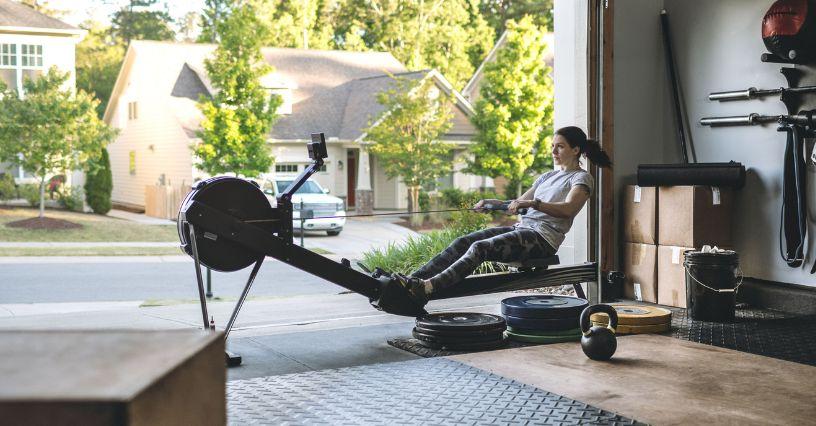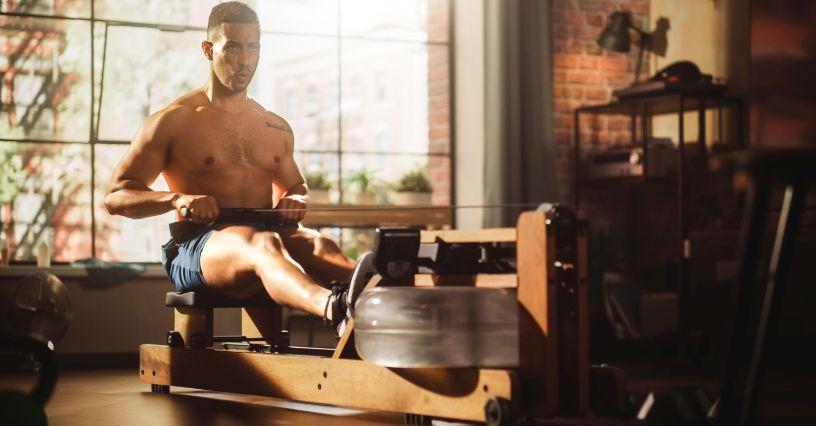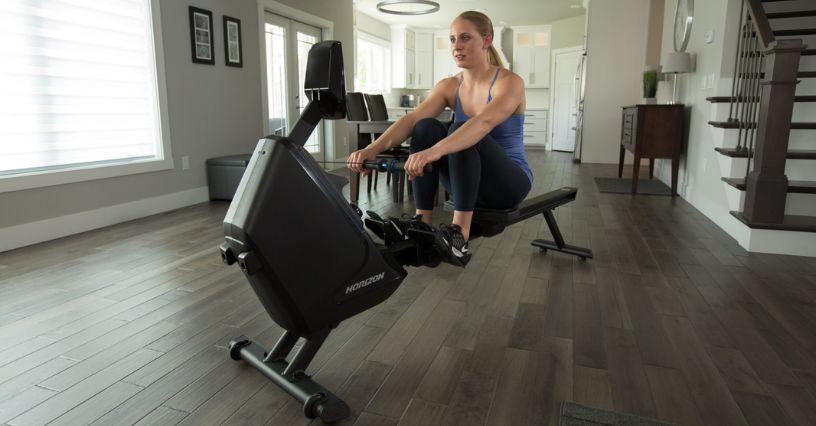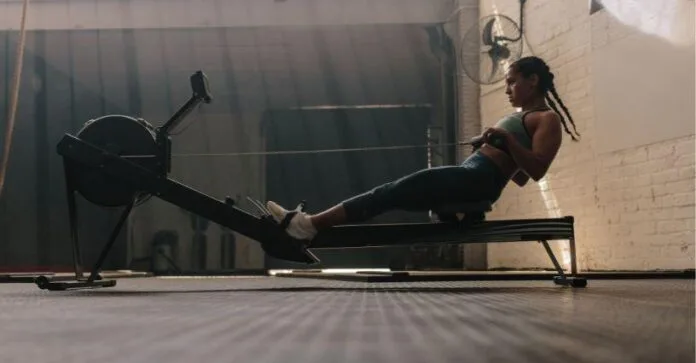The rowing machine has become an integral part of the home gym, providing a complete workout for both beginners and advanced exercise enthusiasts.
However, choosing between a magnetic, water, or air rowing machine can be a challenge. Each of these types of equipment offers unique features and training experiences.
With the help of our guide, you will learn the differences between the types of exercise rowing machines and what parameters to look for when buying to find the machine that best suits your training needs and goals .
The rowing machine: why you should have one at home?
Indoor rowing ergometers allow you to train at any time of the day and regardless of weather conditions. This is ideal, especially when you can’t train outdoors or when you can’t afford regular visits to the gym .
Modern rowing machines offer built-in workouts, adding variety to your workout routine and helping you achieve a variety of goals. Many models of rowing ergometers are equipped with monitors that monitor key parameters such as time, distance, pace and calories burned .
This allows you to effectively monitor your progress and adapt your training to your own goals. Exercise rowing machines are often compact and foldable, which makes them easy to store and allows them to be used even in small domestic spaces. In addition, the availability of equipment at all times encourages regular physical activity .
The exercise rowing machine provides a comprehensive workout, engaging multiple muscle groups simultaneously. Rowing involves working the muscles of the legs, back, arms, abdomen and chest, making it an effective form of cardio, strength or conditioning training .
Rowing is a great way to support weight loss. One hour of physical exercise burns up to 1,000 kcal – depending on the intensity of the training and individual parameters such as weight, height, age, etc. In addition, training on a rowing machine does not put excessive stress on the joints, so there is no high risk of injury .

Magnetic, water or air? Types of rowing machines for exercise
There are several categories of rowing ergometers – mechanical, magnetic, water, hydraulic and air . Each generates resistance in a different way and therefore provides a different training experience and benefits .
The mechanical rowing machine
Mechanical ergometers are the most basic type of rowing machine, where resistance is generated by simple spring or chain mechanisms. The load is usually fixed and manually adjustable, which means that the user has to adjust it manually.
Because of this, the resistance in this type of ergometer is not as accurate as with magnetic or pneumatic models. Mechanical ergometers operate relatively quietly, which can be beneficial for those who prefer a quiet training environment.
In addition to their simple construction and minimalist design, they have the advantage of being affordable and do not require electricity, which means they can be used anywhere .
The magnetic rowing machine
Magnetic rowing machines offer smooth and quiet operation, the ability to adjust the intensity of your workout using an electronic magnetic system, and additional features such as training programs and progress monitoring to add even more variety to your exercise routine.
The resistance in this fitness equipment is generated with the help of magnets, ensuring that the difficulty level of the workout can be precisely adjusted to suit individual needs and goals.
The load of professional magnetic rowing machines is adjusted electronically via a control panel. Magnetic rowing machines are usually compact and offer a folding option for easy storage .

The water rowing machine
Water ergometers mimic the realistic experience of rowing on water. The resistance is generated by a rotating rotor in a pool of water, giving the feeling of natural movement. The harder you row, the more resistance you generate. This provides a precise way to adjust the resistance to individual preference.
A water rowing machine is an excellent choice for people who want to experience the authentic sensation of floating on water while appreciating the dynamic nature of the workout. Water rowing machines often have an attractive and aesthetic design, which makes them not only functional, but also a decorative element in the room .
The air rowing machine
Air ergometers use a rotor that moves through the air, generating resistance proportional to the force you put into rowing. This makes them suitable for people of all levels, from beginners to advanced athletes.
Air rowers offer a smooth rowing motion, which translates into a natural and comfortable workout. Due to air resistance, these types of rowing machines provide a realistic rowing experience similar to that which can be obtained on water .
Compared to other types of ergometers, air models may generate some noise during exercise due to the movement of air in the rotor
However, modern appliances are usually equipped with silencers to minimize this effect. The construction of air rowing machines is usually robust and durable, making them able to withstand heavy use .
Hydraulic rowing machine
Hydraulic rowing ergometers are a type of exercise equipment that uses the resistance generated by hydraulic cylinders located in the oars. The resistance can be adjusted using a dial located on the device. Rowing machines with a hydraulic resistance system are compact and easy to store.
They have a relatively simple design, quiet operation and are affordable, which makes them popular among those looking for an ergonomic and cost-effective solution for home training .
They can provide a simple monitor to keep track of basic training parameters such as time, distance and calories burned. They are recommended for beginners who are at the beginning of their rowing training .

What else to pay attention to when choosing a home rowing machine?
Before deciding what kind of exercise rowing machine to buy for your home, consider your own preferences for the types of workouts you plan to do with this piece of fitness equipment.
If you prefer an intense workout that adapts to your pace and strength, an air rowing machine will be an effective solution.
Do you practice rowing or kayak-canoeing and want the most realistic paddling experience possible ? A water ergometer that mimics the motion of rowing in open water would be an ideal choice.
Need precise resistance control and a variety of training programs? Opt for a magnetic rowing machine with an easy-to-use control panel, an easy-to-read monitor that gives you vital training information and connectivity with training apps .
Determine your budget and how much space you can allocate for a rowing machine in your home. Check the dimensions (total and when folded, if the equipment offers this option) and the weight of the device.
If space is limited, consider folding or compact models (such as a hydraulic rowing machine) that are easy to transport and store.
If you have a separate room developed for a home gym, you can opt for a fixed and robust model that is sized to fit the space, taking into account the rest of the equipment .
Other factors to consider when choosing a home rowing machine include :
- capacity – determines the maximum weight of the user that the rowing machine can support to maintain stability and safety during training. Correctly adjusting the load capacity to suit the needs of a particular user or several practitioners also influences the lifetime of the device ;
- resistance adjustment mode – it can be adjusted manually, for example, using a dedicated rotary knob, or electronically, using a control panel ;
- slide rail length – Make sure it is appropriate for your height. Especially for tall people, make sure it offers a full range of motion ;
- display – choose a model with an easy-to-read and intuitive-to-use screen, where you can easily and conveniently monitor training information such as time (total, for 500m, for 1km, etc.), distance, pace, number of rowing movements per minute or calories burned ;
- training programs – if you are looking for variety in your training, choose a rowing machine with different training programs such as: intervals, water route simulations, etc. Bluetooth connectivity is also useful, allowing the use of mobile devices equipped with dedicated training applications during training ;
- heart rate measurement – the heart rate monitoring function (e.g. via wireless chest straps) allows you to control the intensity of your training and thus achieve your goals more precisely, e.g. strength training, endurance training , weight loss, etc. ;
- adjustable safety devices for the feet – prevent the feet from slipping during intensive training, which is essential for maintaining stability and performing the correct rowing movements ;
- saddle adjustment – allows you to adjust its height according to the individual preferences of the user. This affects training comfort and allows optimal range of motion during rowing. Especially important if the device is to be used by several people ;
- transport wheels – make it easier to move the equipment, which is especially important if you plan to move the rowing machine after a workout ;
- smartphone or tablet holder – allows safe use of a mobile device during exercise .
It is also worth equipping ourselves with a mat under the training equipment , which will protect the floor from possible damage, scratches or sweat and provide a stable training surface, which can be important during dynamic movements.
It also prevents equipment from sliding on the floor, which can make training safer. In addition, the mat can also act as a sound insulator, helping to minimize noise and disturbance to other members of the household or neighbors. When choosing an exercise mat, it’s worth looking at its size, thickness, durability and construction material.



